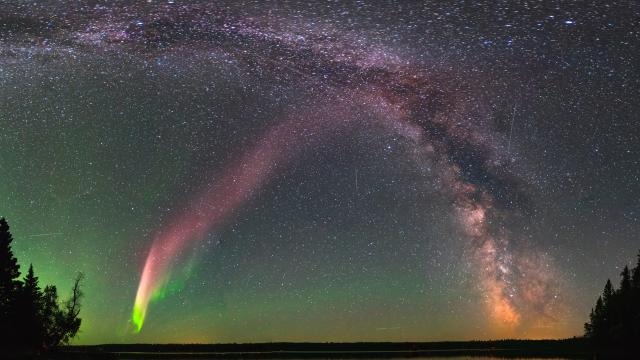It wasn’t scientists who discovered the thin, purple, east-to-west travelling glow in the northern night sky. It was people with cameras and a nerdy passion for auroras.
STEVE and the Milky Way. Photo: Andy Witteman
This week, researchers gave an official proposal to name this structure first observed by citizen scientists A Strong Thermal Emission Velocity Enhancement (STEVE), along with an idea behind STEVE’s cause. Studying these structures would be much harder without citizen scientists’ help.
“It’s gratifying to show what citizen science can do,” Elizabeth MacDonald, the study’s lead author from the NASA Goddard Space Flight Center, told Gizmodo. “Some people think it’s just education and outreach, but it’s actually real science, and people working together in ways that we never anticipated.”
The aurora borealis (and aurora australis) are the so-called northern (and southern) lights, produced from the Sun’s radiation interacting with Earth’s magnetic field. It appears as coloured shows in the near-polar skies.
Amateur aurora chasers only reported STEVE relatively recently, says a new paper in Science Advances. It’s a feature previously called “proton arcs” by aurora chasers, but it doesn’t have the same appearance that protons would cause in the aurora.
In order to understand STEVE, scientists relied on their own measurements from the University of Calgary’s all-sky imagers, as well as digital photographs from amateurs. European Space Agency Satellites further measured the feature.

STEVE over Lake Minnewanka. Photo: Paolo Fedozzi
Combining the data led to the researchers’ hypothesis, that a feature called the “subauroral ion drift” (SAID) is responsible for STEVE. These are particles flowing westward, faster than the speed of sound, in thin jets closer to the equator than the rest of the lights.
SAIDs don’t usually come with lights, and those that do aren’t fully explained yet, according to the paper. Some emissions tied to SAIDs are red, but STEVEs are green – so there’s more science left to be done.
Citizen scientists played a crucial role in all this, explained MacDonald. “They can see this more distinctly with a camera than some of our ground-based cameras, because people can notice it, point to it, and get a higher resolution image.” People can also help explain how common the emission is – after almost two years of observations, it appears that STEVEs don’t occur in the winter, for example.
And it was really the citizen scientists driving the project, and the ones who asked professional scientists for help. The authors write: “This example can help change the nature of scientific engagement between the scientific community and citizen scientists and move communication from one way to two way, with curiosity transitioning to participation and finally to stewardship.”
